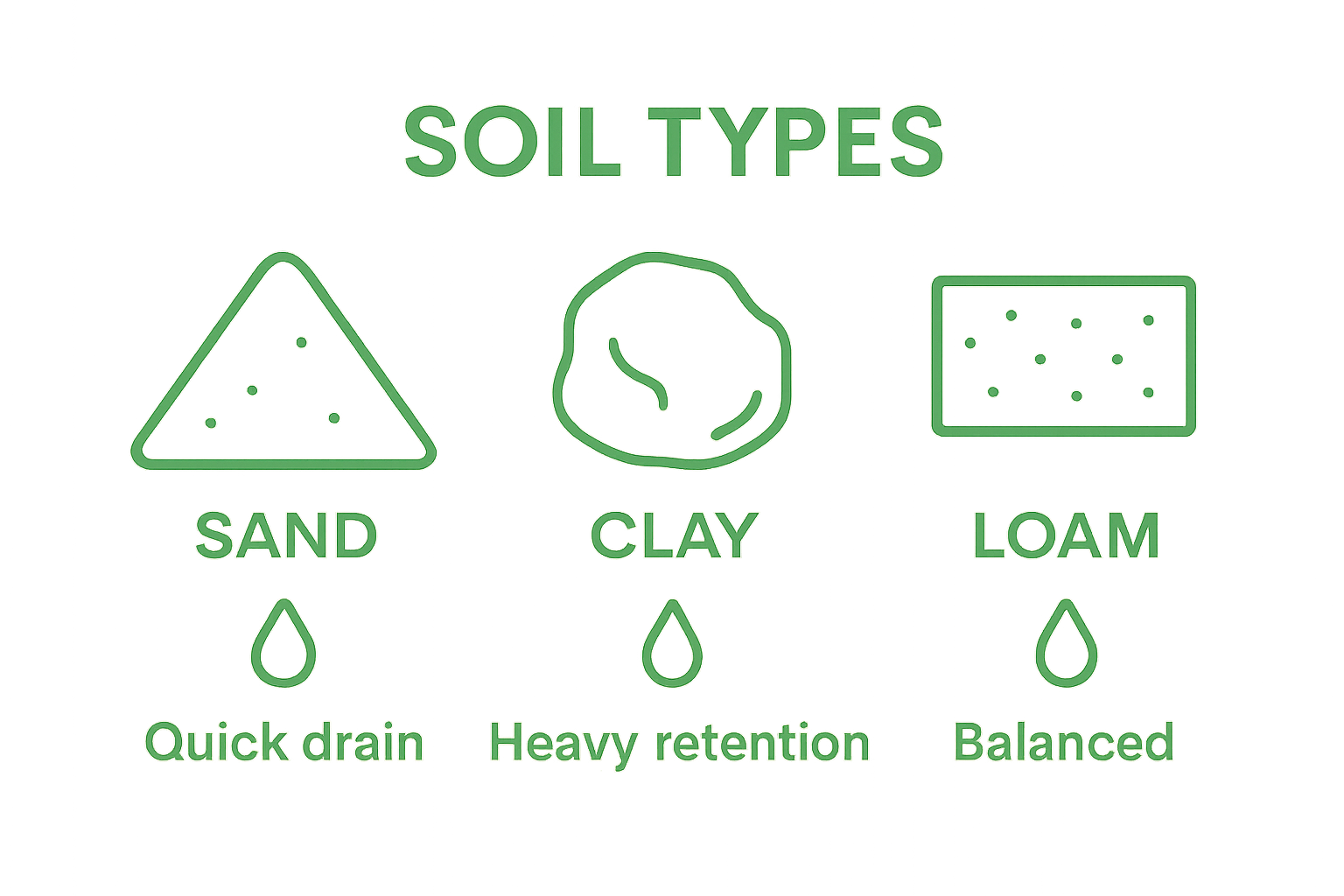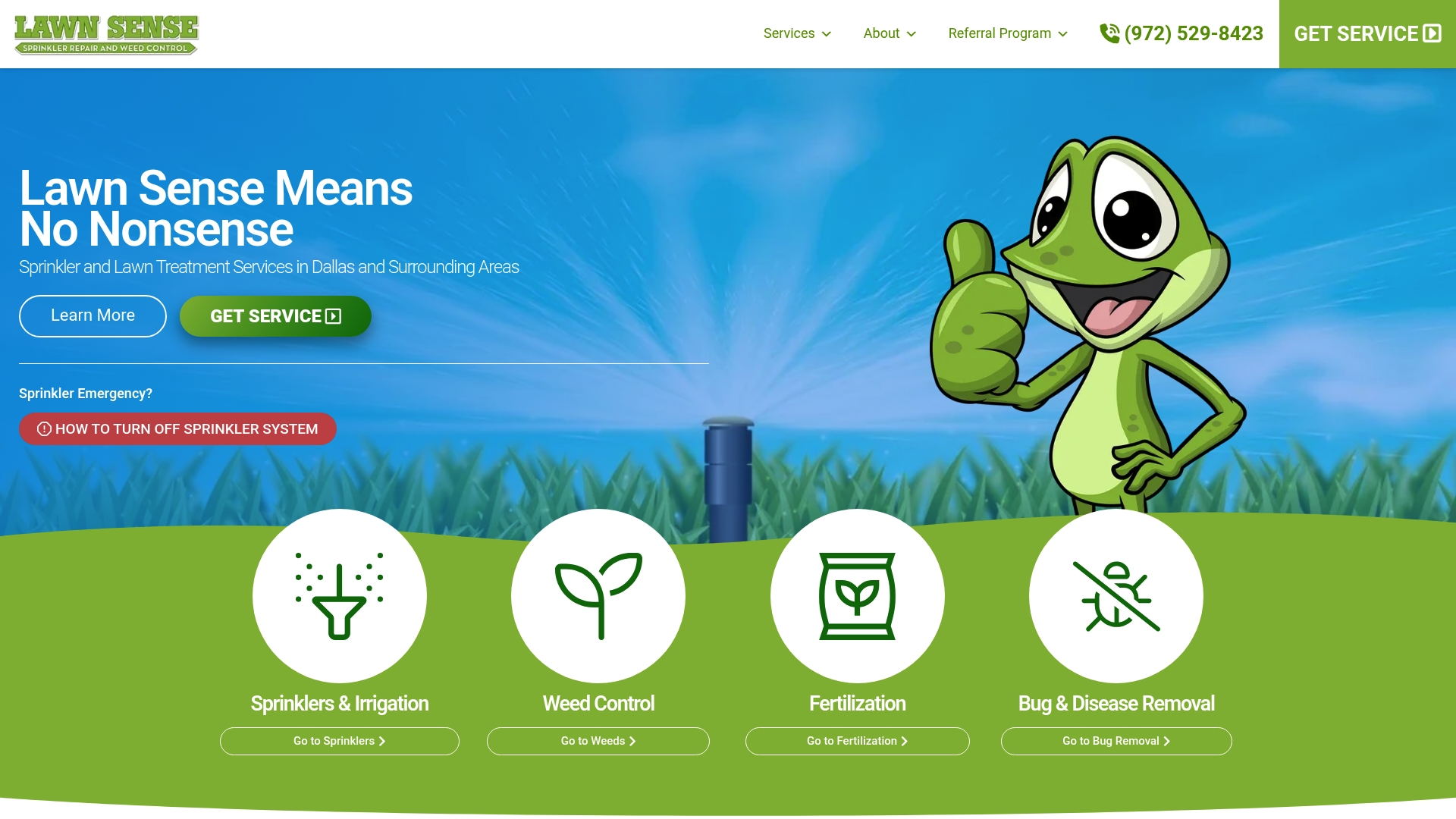Keeping your lawn green all summer sounds simple, just turn on the sprinklers and go. Yet the reality is that overwatering can lead to shallow roots and wasted water, and underwatering can cause permanent damage to turf. Most people imagine irrigation is just about getting grass wet, but that is only a tiny piece of the puzzle. The real magic comes from knowing exactly how much water your lawn needs, which can actually make your grass tougher and help it survive droughts better than you think.
Table of Contents
- What Is Irrigation And Its Importance For Lawns?
- Why Proper Irrigation Is Crucial For Lawn Health
- How Irrigation Systems Work To Nourish Lawns
- Key Factors Influencing Irrigation Efficiency In Lawns
- Real-World Impact Of Irrigation On Lawn Sustainability
Quick Summary
| Takeaway | Explanation |
|---|---|
| Understand your lawn’s water needs. | Different grass types, soil types, and climate conditions dictate unique watering requirements. |
| Implement effective irrigation techniques. | Proper watering encourages deeper roots and enhances lawn health, making it more resilient. |
| Balance is crucial: avoid over and underwatering. | Overwatering leads to shallow roots and disease, while underwatering causes stress and stunted growth. |
| Use modern irrigation systems for efficiency. | Advanced systems with sensors provide precise water delivery, adapting to real-time conditions. |
| Practice sustainable watering methods. | Efficient irrigation conserves water and supports local ecosystems while maintaining a healthy lawn. |
What is Irrigation and Its Importance for Lawns?
Irrigation is the systematic process of supplying water to landscapes and lawns to maintain optimal plant health and growth. At its core, irrigation represents a critical strategy for ensuring your lawn receives consistent moisture necessary for survival and thriving conditions. Learn more about our irrigation expertise.
Understanding Lawn Water Requirements
Every lawn has unique water requirements that depend on multiple factors including grass type, soil composition, local climate, and seasonal variations. According to research from the University of Massachusetts, efficient lawn watering involves understanding these specific needs to promote robust root development and resilient turf.
Key considerations for lawn water requirements include:
- Grass Species: Different grass types have varying water consumption rates
- Soil Drainage: Sandy soils require more frequent watering compared to clay-based soils
- Climate Conditions: Temperature, humidity, and rainfall significantly impact irrigation needs
The Science Behind Effective Irrigation
Effective irrigation goes beyond simply applying water. It involves strategic water application that promotes deep root growth, enhances soil health, and supports overall lawn ecosystem sustainability. The goal is not just to wet the surface but to encourage grass roots to grow deeper, creating a more drought-resistant and healthier lawn.
Proper irrigation techniques help lawns develop strong root systems, improve grass density, and naturally resist weeds and pest invasions. By providing consistent, measured moisture, you enable grass to develop resilience against environmental stressors and maintain a lush, green appearance throughout different seasons.
Why Proper Irrigation is Crucial for Lawn Health
Proper irrigation represents the foundation of maintaining a healthy, vibrant lawn. Beyond simple water application, strategic irrigation ensures your landscape receives the precise moisture needed for sustained growth and resilience. Check out our comprehensive lawn care guides to understand the nuanced approach required for optimal lawn maintenance.
The Impact of Water on Lawn Ecosystem
Water plays a critical role in supporting the complex ecosystem within your lawn. According to research from Purdue University, consistent and appropriate moisture levels directly influence multiple aspects of lawn health, including:
- Root Development: Proper hydration promotes deeper, stronger root systems
- Nutrient Absorption: Water helps transport essential minerals through the grass
- Temperature Regulation: Adequate moisture helps grass withstand heat stress
Consequences of Inadequate Irrigation
Insufficient or inconsistent watering can lead to significant lawn deterioration. Grass becomes vulnerable to multiple environmental stressors when its water requirements are not met. Drought stress weakens grass, making it susceptible to disease, pest invasions, and potential permanent damage.
Understanding the delicate balance of lawn hydration means recognizing that both overwatering and underwatering can cause substantial harm. Overwatered lawns develop shallow root systems and become prone to fungal diseases, while underwatered lawns experience stunted growth, yellowing, and potential complete turf failure. The key is developing a precise, tailored irrigation strategy that matches your specific lawn’s unique environmental conditions and grass type.
How Irrigation Systems Work to Nourish Lawns
Irrigation systems are sophisticated networks designed to deliver precise water distribution across lawn landscapes. These systems transform water management from a manual, inconsistent process into a controlled, efficient mechanism for maintaining optimal lawn health. Learn more about our watering strategies.
Components of Effective Irrigation Systems
According to research from Virginia Tech, modern irrigation systems incorporate multiple critical components that work together to ensure precise water delivery:
The following table summarizes the main components of effective irrigation systems and their respective functions. This structure makes it easy for readers to grasp the role of each part within a modern lawn irrigation setup.
| Component | Function |
|---|---|
| Sprinkler Heads | Distribute water evenly across designated lawn zones. |
| Control Valves | Regulate water flow and maintain appropriate pressure. |
| Moisture Sensors | Measure soil hydration levels to adjust watering. |
| Rain Sensors | Automatically halt irrigation during rainfall events. |
- Sprinkler Heads: Distribute water uniformly across different lawn zones
- Control Valves: Regulate water flow and pressure
- Moisture Sensors: Detect current soil hydration levels
- Rain Sensors: Prevent unnecessary watering during rainfall
Water Distribution and Absorption Mechanics
The primary goal of an irrigation system extends beyond simple water application. These systems are engineered to mimic natural rainfall patterns, ensuring water penetrates soil effectively and reaches grass root zones. Sophisticated systems use varying spray patterns and droplet sizes to maximize water absorption and minimize surface runoff.
Water distribution involves understanding complex interactions between soil composition, grass type, and environmental conditions. Professional irrigation systems strategically adjust water volume and frequency based on real-time environmental data, creating a dynamic approach to lawn hydration that adapts to changing seasonal requirements. By delivering water directly to root zones and controlling precise moisture levels, these systems support robust grass growth while conserving water resources.
Key Factors Influencing Irrigation Efficiency in Lawns
Irrigation efficiency represents a complex interplay of environmental, technological, and biological factors that determine how effectively water reaches and nourishes lawn ecosystems. Understanding these critical elements can transform lawn care from a guesswork approach to a precision science. Explore our comprehensive DFW watering strategies.
Soil Characteristics and Water Dynamics
According to Penn State Extension, soil properties profoundly impact irrigation efficiency.

Different soil types have unique water absorption and retention capabilities that directly influence how moisture penetrates and supports grass root systems:
Below is a comparison table highlighting how different soil types impact irrigation frequency and effectiveness. This organization helps readers quickly understand the relationship between soil characteristics and their influence on lawn watering needs.
| Soil Type | Water Absorption | Water Retention | Irrigation Implications |
|---|---|---|---|
| Sandy | Rapid | Low | Requires more frequent watering due to quick drainage. |
| Clay | Slow | High | Prone to water retention; may risk root suffocation if overwatered. |
| Loam | Moderate | Balanced | Optimal for lawn growth; retains and drains water well. |
- Sandy Soils: Rapid drainage, requiring more frequent watering
- Clay Soils: Slower absorption, prone to water retention and potential root suffocation
- Loamy Soils: Optimal water retention and drainage characteristics
Environmental and Technological Influences
Irrigation efficiency extends beyond soil composition, encompassing multiple interconnected factors. Temperature, humidity, wind conditions, and sunlight exposure dramatically affect water evaporation and absorption rates. Modern irrigation technologies leverage advanced sensors and smart controllers to dynamically adjust watering schedules, compensating for real-time environmental fluctuations.
Professional irrigation management involves creating a holistic approach that considers grass species, microclimate conditions, and seasonal variations. By understanding these nuanced interactions, homeowners can develop targeted irrigation strategies that optimize water usage, reduce waste, and promote healthier, more resilient lawn ecosystems.
Real-World Impact of Irrigation on Lawn Sustainability
Irrigation practices extend far beyond maintaining green landscapes, representing a critical intersection of environmental stewardship, resource conservation, and ecological balance. Sustainable irrigation strategies can significantly reduce water waste, protect local ecosystems, and create resilient lawn environments. Learn about optimal watering techniques.
Environmental Conservation Through Smart Irrigation
According to research from the University of Massachusetts Amherst, efficient irrigation practices play a pivotal role in water resource management. Strategic water application minimizes unnecessary consumption and prevents potential environmental complications:
- Reduced Water Runoff: Prevents soil erosion and chemical contamination
- Groundwater Protection: Minimizes unnecessary water extraction
- Ecosystem Preservation: Supports local biodiversity and soil health
Economic and Ecological Benefits
Sustainable irrigation practices yield multifaceted benefits beyond immediate lawn appearance. By implementing precision watering techniques, homeowners can simultaneously reduce water bills, minimize environmental impact, and create healthier lawn ecosystems. Professional irrigation management considers complex interactions between soil composition, grass species, and microclimate conditions to develop targeted strategies that optimize water usage.

Ultimately, irrigation sustainability represents a holistic approach to landscape management. It transforms lawn care from a resource-intensive practice to an environmentally responsible system that balances aesthetic desires with ecological considerations.
Transform Your Lawn Health With Expert Irrigation Guidance
Struggling to keep your lawn green, even after watering? The article explains how proper irrigation shapes root growth, water absorption and overall lawn resilience. Many homeowners find it hard to create the right balance, leading to either dry patches or wasted water. If you feel overwhelmed by all the technical details, you are not alone. That is why you deserve specialized support that matches your unique soil, grass and climate needs. Unlock practical solutions and get answers tailored to DFW lawns in our Guides – Lawn and Sprinkler Systems section.

Your healthy, lush lawn is only a step away. Visit Lawn Sense now to explore our expert resources and see why so many DFW homeowners trust us for superior sprinkler care, weed control and disease prevention. Take action today to set your lawn on the path to lasting health. Your best results start with the right irrigation strategy—discover them with us.
Frequently Asked Questions
What is irrigation and why is it important for lawn health?
Irrigation is the process of supplying water to lawns to maintain optimal plant health. It ensures consistent moisture for survival, promoting deep root growth and overall lawn resilience.
How do I determine my lawn’s water requirements?
To determine your lawn’s water requirements, consider factors such as grass type, soil composition, climate, and seasonal variations. Understanding these elements helps promote healthy growth and resilience.
What are the consequences of inadequate irrigation?
Inadequate irrigation can lead to stunted growth, yellowing grass, and increased vulnerability to diseases and pests. Both overwatering and underwatering can cause significant harm to your lawn’s health.
How can modern irrigation systems improve lawn care?
Modern irrigation systems use advanced technologies like moisture sensors and smart controllers to deliver precise water distribution. This encourages deeper root growth and minimizes water waste, enhancing overall lawn health.